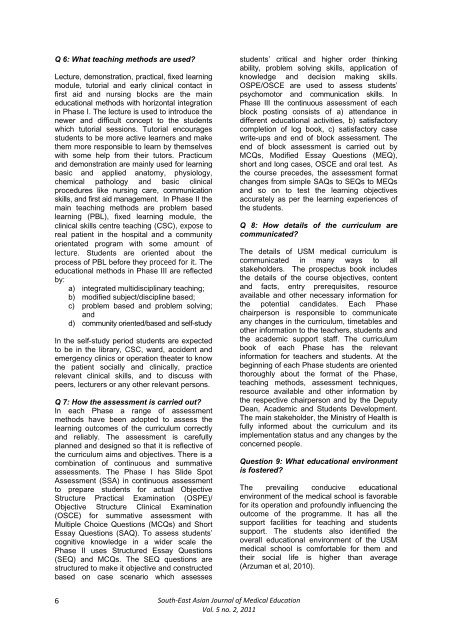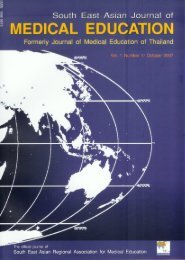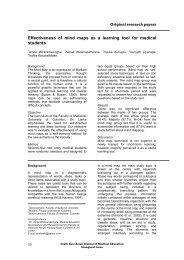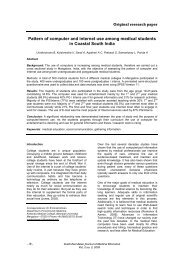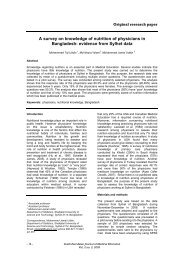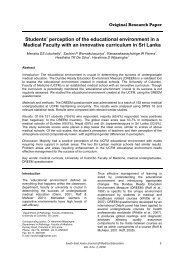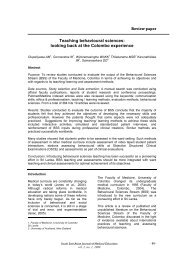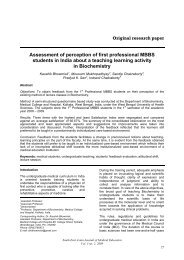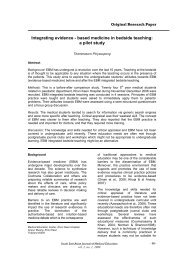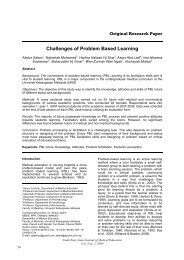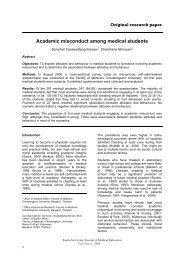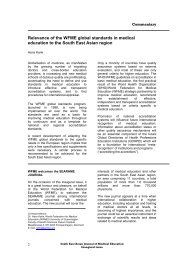Undergraduate Medical Curriculum of Universiti Sains Malaysia in ...
Undergraduate Medical Curriculum of Universiti Sains Malaysia in ...
Undergraduate Medical Curriculum of Universiti Sains Malaysia in ...
You also want an ePaper? Increase the reach of your titles
YUMPU automatically turns print PDFs into web optimized ePapers that Google loves.
Q 6: What teach<strong>in</strong>g methods are used<br />
Lecture, demonstration, practical, fixed learn<strong>in</strong>g<br />
module, tutorial and early cl<strong>in</strong>ical contact <strong>in</strong><br />
first aid and nurs<strong>in</strong>g blocks are the ma<strong>in</strong><br />
educational methods with horizontal <strong>in</strong>tegration<br />
<strong>in</strong> Phase I. The lecture is used to <strong>in</strong>troduce the<br />
newer and difficult concept to the students<br />
which tutorial sessions. Tutorial encourages<br />
students to be more active learners and make<br />
them more responsible to learn by themselves<br />
with some help from their tutors. Practicum<br />
and demonstration are ma<strong>in</strong>ly used for learn<strong>in</strong>g<br />
basic and applied anatomy, physiology,<br />
chemical pathology and basic cl<strong>in</strong>ical<br />
procedures like nurs<strong>in</strong>g care, communication<br />
skills, and first aid management. In Phase II the<br />
ma<strong>in</strong> teach<strong>in</strong>g methods are problem based<br />
learn<strong>in</strong>g (PBL), fixed learn<strong>in</strong>g module, the<br />
cl<strong>in</strong>ical skills centre teach<strong>in</strong>g (CSC), expose to<br />
real patient <strong>in</strong> the hospital and a community<br />
orientated program with some amount <strong>of</strong><br />
lecture. Students are oriented about the<br />
process <strong>of</strong> PBL before they proceed for it. The<br />
educational methods <strong>in</strong> Phase III are reflected<br />
by:<br />
a) <strong>in</strong>tegrated multidiscipl<strong>in</strong>ary teach<strong>in</strong>g;<br />
b) modified subject/discipl<strong>in</strong>e based;<br />
c) problem based and problem solv<strong>in</strong>g;<br />
and<br />
d) community oriented/based and self-study<br />
In the self-study period students are expected<br />
to be <strong>in</strong> the library, CSC, ward, accident and<br />
emergency cl<strong>in</strong>ics or operation theater to know<br />
the patient socially and cl<strong>in</strong>ically, practice<br />
relevant cl<strong>in</strong>ical skills, and to discuss with<br />
peers, lecturers or any other relevant persons.<br />
Q 7: How the assessment is carried out<br />
In each Phase a range <strong>of</strong> assessment<br />
methods have been adopted to assess the<br />
learn<strong>in</strong>g outcomes <strong>of</strong> the curriculum correctly<br />
and reliably. The assessment is carefully<br />
planned and designed so that it is reflective <strong>of</strong><br />
the curriculum aims and objectives. There is a<br />
comb<strong>in</strong>ation <strong>of</strong> cont<strong>in</strong>uous and summative<br />
assessments. The Phase I has Slide Spot<br />
Assessment (SSA) <strong>in</strong> cont<strong>in</strong>uous assessment<br />
to prepare students for actual Objective<br />
Structure Practical Exam<strong>in</strong>ation (OSPE)/<br />
Objective Structure Cl<strong>in</strong>ical Exam<strong>in</strong>ation<br />
(OSCE) for summative assessment with<br />
Multiple Choice Questions (MCQs) and Short<br />
Essay Questions (SAQ). To assess students’<br />
cognitive knowledge <strong>in</strong> a wider scale the<br />
Phase II uses Structured Essay Questions<br />
(SEQ) and MCQs. The SEQ questions are<br />
structured to make it objective and constructed<br />
based on case scenario which assesses<br />
students’ critical and higher order th<strong>in</strong>k<strong>in</strong>g<br />
ability, problem solv<strong>in</strong>g skills, application <strong>of</strong><br />
knowledge and decision mak<strong>in</strong>g skills.<br />
OSPE/OSCE are used to assess students’<br />
psychomotor and communication skills. In<br />
Phase III the cont<strong>in</strong>uous assessment <strong>of</strong> each<br />
block post<strong>in</strong>g consists <strong>of</strong> a) attendance <strong>in</strong><br />
different educational activities, b) satisfactory<br />
completion <strong>of</strong> log book, c) satisfactory case<br />
write-ups and end <strong>of</strong> block assessment. The<br />
end <strong>of</strong> block assessment is carried out by<br />
MCQs, Modified Essay Questions (MEQ),<br />
short and long cases, OSCE and oral test. As<br />
the course precedes, the assessment format<br />
changes from simple SAQs to SEQs to MEQs<br />
and so on to test the learn<strong>in</strong>g objectives<br />
accurately as per the learn<strong>in</strong>g experiences <strong>of</strong><br />
the students.<br />
Q 8: How details <strong>of</strong> the curriculum are<br />
communicated<br />
The details <strong>of</strong> USM medical curriculum is<br />
communicated <strong>in</strong> many ways to all<br />
stakeholders. The prospectus book <strong>in</strong>cludes<br />
the details <strong>of</strong> the course objectives, content<br />
and facts, entry prerequisites, resource<br />
available and other necessary <strong>in</strong>formation for<br />
the potential candidates. Each Phase<br />
chairperson is responsible to communicate<br />
any changes <strong>in</strong> the curriculum, timetables and<br />
other <strong>in</strong>formation to the teachers, students and<br />
the academic support staff. The curriculum<br />
book <strong>of</strong> each Phase has the relevant<br />
<strong>in</strong>formation for teachers and students. At the<br />
beg<strong>in</strong>n<strong>in</strong>g <strong>of</strong> each Phase students are oriented<br />
thoroughly about the format <strong>of</strong> the Phase,<br />
teach<strong>in</strong>g methods, assessment techniques,<br />
resource available and other <strong>in</strong>formation by<br />
the respective chairperson and by the Deputy<br />
Dean, Academic and Students Development.<br />
The ma<strong>in</strong> stakeholder, the M<strong>in</strong>istry <strong>of</strong> Health is<br />
fully <strong>in</strong>formed about the curriculum and its<br />
implementation status and any changes by the<br />
concerned people.<br />
Question 9: What educational environment<br />
is fostered<br />
The prevail<strong>in</strong>g conducive educational<br />
environment <strong>of</strong> the medical school is favorable<br />
for its operation and pr<strong>of</strong>oundly <strong>in</strong>fluenc<strong>in</strong>g the<br />
outcome <strong>of</strong> the programme. It has all the<br />
support facilities for teach<strong>in</strong>g and students<br />
support. The students also identified the<br />
overall educational environment <strong>of</strong> the USM<br />
medical school is comfortable for them and<br />
their social life is higher than average<br />
(Arzuman et al, 2010).<br />
6 South‐East Asian Journal <strong>of</strong> <strong>Medical</strong> Education<br />
Vol. 5 no. 2, 2011


